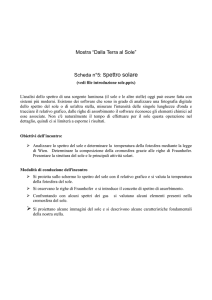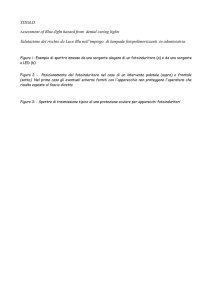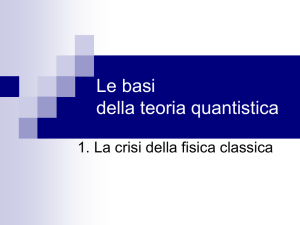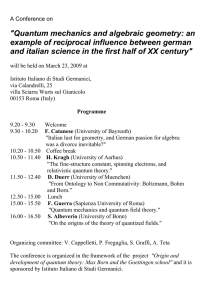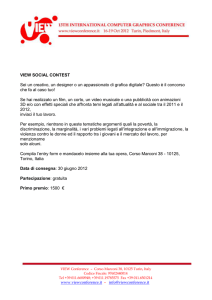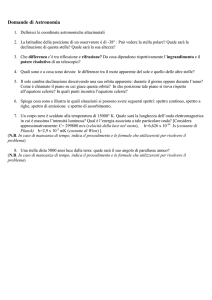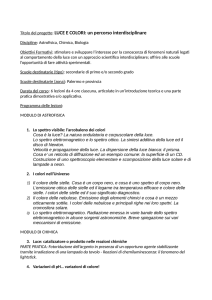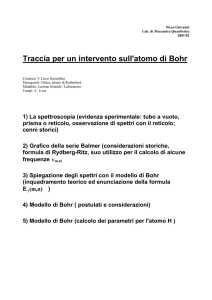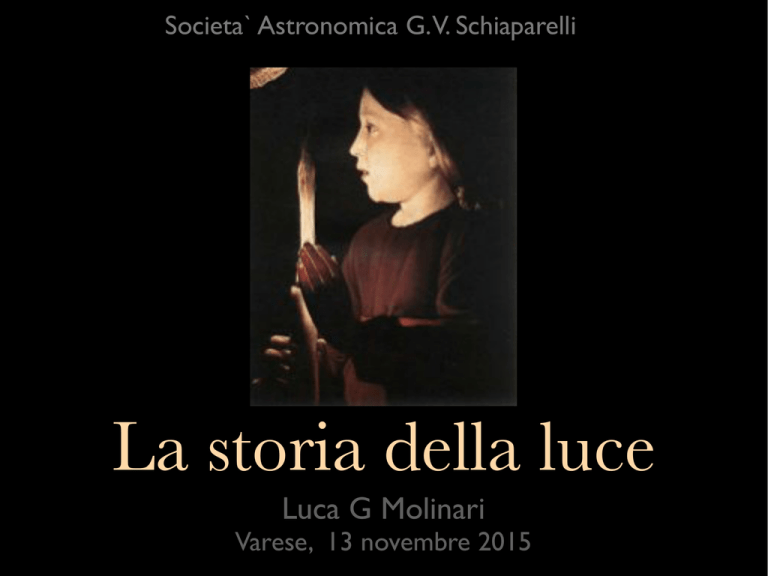
Societa` Astronomica G.V. Schiaparelli
La storia della luce
Luca G Molinari
Varese, 13 novembre 2015
Georges de La Tour (1642) - Louvre
2015 ANNO DELLA LUCE
150 ANNI DELLE LEGGI DELL’ELETTROMAGNETISMO
COSA E` LA LUCE?
ESO/H.H. Heyer
DUECENTO ANNI DI STORIA DELLA FISICA e
DELLA LUCE
Lo spettro della luce
Nel 1666 ISAAC NEWTON
dimostro` che la luce bianca del Sole
e` scomponibile in un continuo di
colori (lo spettro).
!
(si pensava che i colori fossero dovuti al prisma, e non fossero una
proprieta` intrinseca della luce)
Condusse gli esperimenti nella casa di campagna, per sfuggire alla peste.
La radiazione infrarossa William Herschel - 1800
Luce e calore radiante sono forme dello stesso fenomeno
!
… we are not allowed, by the rules of philosophizing, to admit two different
causes to explain certain effects, if they may be accounted for by one.
!
... non ci e` consentito, dalle regole del ragionamento,
ammettere due differenti cause per spiegare certi effetti, se questi possono essere spiegati da una sola.
(1738-1822)
VIS
IR
GOES 9 satellite meteo
35,000 km sull’equatore e
Oceano Pacifico orientale
(Genn 1997)
Telescopio spaziale Herschel - IR
lanciato nel 2009 insieme al satellite Planck
... e della galassia M31
Le polveri della Via Lattea
La radiazione UV (1801)
Johann Wilhem Ritter
Una radiazione invisibile oltre il violetto impressiona carta impregnata con sali d’argento (piu` che la radiazione violetta)
~100%
I raggi UVC (e parte dei B) sono bloccati dall’ozono
stratosferico tra 10 e 40 km dove la temperatura cresce con la quota (3 molecole O3 ogni 10 milioni)
Sole in UV e transito di Venere (2012)
SolarDynamicsObservatory (NASA)
(BetaAnd,laschiena)
Cygnus Loop Nebula (d=1500 a.l., SN 5-8mila anni fa)
Galex ultraviolet telescope
Galex, M33 (d=3milioni a.l.)
LA SPETTROSCOPIA
1814
Joseph Fraunhofer
(Monaco 1787 - 1826)
Le linee di Fraunhofer (1814)
D
Joseph Fraunhofer osservo`che lo spettro del Sole, quando
sufficientemente disperso, e` attraversato da molte sottili linee scure (ne conto` piu` di 500). !
W. H. Wollaston le aveva gia`osservate nel 1802, senza attribuirvi significato.
Fraunhofer studio` gli spettri di molti corpi celesti. Quello della Luna mostrava le stesse linee nere del Sole. Noto` che le linee brillanti del Sodio corrispondono alle riga scura D nello spettro solare; ma non fu in grado di darne spiegazione.
Gustav Robert Kirchoff
(1824-1887)
&
Robert Wilhem Bunsen
(1811-1899)
Il sodalizio ebbe inizio nel 1850 a Breslavia
dove Kirchhoff insegnava e dove, poco dopo,
arrivò Bunsen. Trasferitosi Bunsen ad Heidelberg, Kirchhoff lo seguì nel 1854.
!
Kirchhoff e Bunsen posero le basi dell'analisi spettroscopica, scoprendo che ogni riga spettrale è caratteristica
dell'elemento chimico che la emette.
Li
Na
Cu
Ca
K
Na - SODIO
emissione
gas
Na
assorbimento
Un gas che emette uno spettro di linee
deve, alla stessa temperatura,
assorbire lo stesso spettro di linee
CESIO (1860) caesius = azzurro cielo
RUBIDIO (1861) rubidus = rosso cupo
Le linee di Fraunhofer nello spettro solare
sono dovute all’assorbimento dello spettro
continuo (emesso dall’interno del Sole) da parte degli elementi presenti
nell’atmosfera solare piu` fredda.
!
Über die fraunhoferschen Linien
Annalen der Physik (1860)
Lo spettro del Sole
Gli elettroni in campo magnetico compiono moto circolare e collidono con le molecole del gas nell’ampolla, che emettono luce
Oh Be A Fine Girl Kiss Me
Padre Angelo Secchi
Si distinse per l’invenzione di nuovi strumenti
(eliospettroscopio, spettroscopio stellare) e soprattutto
nell’individuazione di 5 classi stellari (di Secchi)
dedotti da quasi 4000 spettri, studiati a partire da 1863.
1) Cupola equatoriale di Merz
3) Cupola circolo meridiano 6) Antenna con il globo in vimini che, sganciato al mezzogiorno, dava il segnale per lo sparo del cannone sul Castel S. Angelo. 7) Cavi elettrici per la trasmissione dei segnali dei sensori
meteorologici al Meteorografo registratore.
Montecitorio.
Osservatorio del Collegio Romano
JAMES CLERK MAXWELL
1831-1879
Diametro: 270 mila km
Spessore:10 m - 1 Km
polveri ghiacciate che
collidono e polverizzano
On the stability of the motion of Saturn’s rings
Premio Adams 1856 (Cambridge)
Gli anelli sono composti da particelle
La prima fotografia a colori
TARTAN RIBBON (1861) eseguita da un fotografo
in tre filtri rosso verde blu
LE EQUAZIONI DI
MAXWELL (1865)
r · E = 4⇡⇢
r·B =0
r⇥E =
1 @B
c @t
r ⇥ B = 4⇡J
1 @E
c @t
r · E = 4⇡⇢
r·B =0
r⇥E =
1 @B
c @t
r ⇥ B = 4⇡J
1 @E
c @t
Gilbert
Coulomb
Volta
Gauss
Ampere
Franklin
Faraday
Biot Savart
Ohm
Oersted
Neumann
Lenz ...
La teoria unificata dell’elettricita` e del magnetismo
Soluzioni delle equazioni di Maxwell senza sorgenti: LE ONDE ELETTROMAGNETICHE
E
B
Il problema dell’etere
L’esperimento di Michelson e Morley (1887)
The special theory of relativity owes its origins to Maxwell's equations
of the electromagnetic field (Albert Einstein)
UNA LUMINOSA SCOPERTA
" The speed of electromagnetic waves is
nearly that of light ... which gives a good
reason to conclude that light is
somehow itself, an electromagnetic
disturbance that propagates under the
laws of electromagnetism "
!
1864, “Dynamical theory of the electromagnetic field”
discorso alla Royal Society, pubblicato nel 1865
I colori che compongono la
luce visibile sono onde e.m.
!
Le onde e.m. sono
caratterizzate da una
lunghezza d’onda.
Trasportano energia e hanno
nel vuoto la stessa velocita`
c =300mila km/s
!
Ogni elemento chimico emette
e assorbe un proprio spettro
di righe (onde e.m.)
Lo spettro elettromagnetico
4000A
?
7500A
?
Gli esperimenti di Hertz
Negli anni 1885 -1889, al Politecnico di Karlsruhe,
Heinrich Hertz fu il primo a produrre e studiare le onde radio,
previste matematicamente da Maxwell
Guglielmo Marconi
Premio Nobel per la Fisica 1909
Nel novembre 1901 costrui`!
a Poldhu (Cornovaglia) un !
grande trasmettitore. !
Poi attraverso` l’Atlantico !
per St. Johns in Terranova, !
a oltre 3.000 chilometri. !
!
Il 12 dicembre 1901 fu !
trasmesso il primo segnale !
radio transoceanico, !
Il messaggio era composto !
da tre punti (la S in codice
Morse) e giunse dopo due
riflessioni sulla ionosfera
(100-400 km).
WirelessTelegraph&SignalCompany.
Ingegneri del British Post Office esaminano un
apparecchio di radio-telegrafia di Marconi (1897)
LA NAVE ELETTRA
Nel 1930 Marconi, invio’
dal porto di Genova gli
impulsi elettrici che
illuminarono il Municio di
Sydney, Australia,
distante 20,000
chilometri.
“My father loved the sea and loved the yacht Elettra''
(Princess Elettra Marconi Giovanelli)
1931, Pio XI e Marconi per la prima
trasmissione radio dal Vaticano
Curie, Marconi, Bohr, Fermi, Majorana, Como 1931
Marconi Memorial a Washington
Nernst (1920), Einstein (1921), Planck (1918)
Millikan (1923), Laue (1914) (foto del 1931)
LA RADIAZIONE DEL CORPO NERO (1900)
(Legge di Planck, dopo una lunga ricerca)
Kirchoff:
E( ,T )
A( ,T )
= f( , T)
funzione universale,
corrispondente
all’emissione
di un corpo ideale con
A=1 (corpo nero)
h
Il fondo cosmico di microonde
L’effetto fotoelettrico
UV
IR
Le onde e.m. cedono energia
alla materia in forma di
particelle senza massa: I FOTONI
Ogni fotone ha energia E
= h⌫
(Einstein 1905)
Max Planck medal - Berlino, 1929,
Le serie spettrali dell’idrogeno
Balmer (1885)
1
= RH
6 5
1
22
4
1
n2
n = 3, 4, 5, . . .
3
Lyman UV (1906)
Paschen IR (1908)
L’ATOMO DI BOHR
~2
a0 =
⇡ 0.5Angstrom
me2
Niels Bohr
Premio Nobel 1922
Rutherford: come fa un elettrone
a sapere su quale orbita saltare?
L’Istituto Niels Bohr a Copenhagen
E’ tutt’oggi finanziato dalla Carlsberg
Il modello di Bohr - Sommerfeld non spiegava
correttamente il MOMENTO ANGOLARE
LA CONFERENZA SOLVAY 1927
LA NUOVA MECCANICA QUANTISTICA
Einstein: 'God does not play dice.'
Bohr:'Einstein, stop telling God what to do.'
!
LA NUOVA MECCANICA QUANTISTICA
I fondatori Heisenberg (1932) Dirac e Schrodinger (1933)
vanno a Stoccolma a ricevere i premi Nobel
Paul A. M. Dirac
1902-1984
La quantizzazione del campo
elettromagnetico (1927)
L’equazione relativistica per
l’elettrone (eqz. di Dirac, 1928)
L’equazione di Dirac
una delle formule piu’ eleganti e sorprendenti della fisica
Westminster Abbey
IL POSITRONE (1932) (Carl D. Anderson - Nobel 1936)
positroni da raggi cosmici, in camera a nebbia
K40
P=19
19 e
N=21
Ar40
P=18
18
e
N=22
I positroni sono emessi nel decadimento radioattivo
p
n + antineutrino + positrone
!
Il Potassio K40 emette positroni (emivita = 1,3 miliardi di anni) ed e` il
radioisotopo piu` abbondante nel corpo umano. (circa 4400 decadimenti al secondo in un uomo di 70 kg. Il positrone si annichila
con l’elettrone e produce due fotoni da 511 keV, in un processo simile - ma di
intensita` assai minore - rispetto a quanto avviene in una PET)
Il Potassio costituisce il 2,4% della massa della crosta terrestre, 1 parte su 10mila e` l’isotopo K40
Le banane sono ricche di potassio.!
La radioattività di un grosso carico di !
banane può far scattare l'allarme degli !
scanner per la radioattività.!
(-->banana equivalent dose)
IL LAMB SHIFT
(Lamb, 1947)
riga H-alpha
alta risoluzione
n=3
riga H-alpha
n=2
interazione
e-vuoto
!
QED
Q.E.D.
(quantum electrodynamics)
Premi Nobel della fisica 1965
SinI&ro
Tomonaga
Richard
Feynman
Julien
Schwinger
RICHARD
FEYNMAN
1918-1988
Principio di Fermat (1662)
Il raggio di luce compie il tragitto con tempo minimo
v
w
I diagrammi di Feynman
PH
VOLUM E 76, NUM BER
YSI CAL REVIE%
6
SEPTEMBER 15, 1940
Space-Time Appxoach to Quantum Electxotiynamics
R. P.
DePartment
FEYNMAN
of Physics, Cornell University, Ithaca, En@ Fork
{Received May 9, 1949)
In this paper two things are done. (1) It is shown that a considerable simplification can be attained in writing down matrix
elements for complex processes in electrodynamics. Further, a
physical point of view is available which permits them to be
written down directly for any specific problem. Being simply a
restatement of conventional electrodynamics, however, the matrix
elements diverge for complex processes. (2) Electrodynamics is
modified by altering the interaction of electrons at short distances,
All matrix elements are now finite, with the exception of those
relating to problems of vacuum polarization. The latter are
evaluated in a manner suggested by Pauli and Bethe, which gives
6nite results for these matrices also. The only effects sensitive to
the modification are changes in mass and charge of the electrons.
Such changes could not be directly observed. Phenomena directly
observable, are insensitive to the details of the modi6cation used
(except at extreme energies). For such phenomena, a limit can
be taken as the range of the modification goes to zero. The results
then agree with those of Schwinger. A complete, unambiguous,
HIS paper should be considered as a direct continuation of a preceding one' (I) in which the
motion of electrons, neglecting interaction, was analyzed, by dealing directly with the solution of the
Hamiltonian diGerential equations. Here the same technique is applied to include interactions and in that way
to express in simple terms the solution of problems in
quantum electrodynamics.
For most practical calculations in quantum electrodynamics the solution is ordinarily expressed in terms
of a matrix element. The matrix is worked out as an
expansion in powers of e'/kc, the successive terms corresponding to the inclusion of an increasing number of
virtual quanta. It appears that a considerable simplification can be achieved in writing down these matrix
FIG. each The
term
elements for complex processes. Furthermore,
in the expansion can be written down and understood
directly from a physical point of view, similar to the
space-time view in I. It is the purpose of this paper to
describe how this may be done. We shall also discuss
methods of handling the divergent integrals which
appear in these matrix elements.
The simplihcation in the formulae results mainly from
the fact that previous methods unnecessarily separated
into individual terms processes that were closely related
a quantum
physically. For example, in the exchange oft&
ts
between two electrons there were two terms depending
on which electron emitted and which absorbed the
quantum. Yet, in the virtual states considered, timing
relations are not significant. Olny the order of operators
'the matrix must be maintained. ~e have seen (I),
t at in addition, processes in which virtual pairs are
1.
and presumably consistent, method is therefore available for the
calculation of all processes involving electrons and photons.
The simpli6cation in writing the expressions results from an
emphasis on the over-all space-time view resulting from a study
of the solution of the equations of electrodynamics, The relation
of this to the more conventional Hamiltonian point of view is
discussed. It would be very difficult to make the modification
which is proposed if one insisted on having the equations in
Hamiltonian form.
The methods apply as well to charges obeying the Klein-Gordon
equation, and to the various meson theories of nuclear forces.
Illustrative examples are given. Although a modi6cation like that
used in electrodynamics can make all matrices finite for all of the
meson theories, for some of the theories it is no longer true that
all directly observable phenomena are insensitive to the details of
the modification used.
The actual evaluation of integrals appearing in the matrix
elements may be facilitated, in the simpler cases, by methods
described in the appendix.
p-k
-I
R. P. FEYNMAN
'—
2)
Eq. (4}.
k
This turns out to be not quite right, ' for when t
interaction is represented by photons they must be
only positive energy, while the Fourier transform
i&(too —
roo) contains frequencies of both signs. It shou
instead be replaced by 8+(r, o —
roo) where
t4, 6)
positive energy electrons are involved. Further, the
eBects of longitudinal and transverse waves can be
combined together. The separations previously made
were on an unrelativistic basis (reflected in the circumstance that apparently momentum but not energy is
conserved in intermediate states). When the terms are
combined and simplified, the relativistic invariance of
the result is self-evident.
We begin by discussing the solution in space and
6, time
of the Schrodinger equation for particles interacting
instantaneously. The results are immediately generalizable to delayed interactions of relativistic electrons
and we represent in that way the laws of quantum
electrodynamics. We can then see how the matrix element for any process can be written down directly. In
interaction
fundamental
down.
expression is written Exchange
particular, the self-energy
restatethan
a
other
been
done
has
So
nothing
two
electrons.
far,
between
quantum
rnent of conventional electrodynamics in other terms.
Therefore, the self-energy diverges. A modification' in
interaction between charges is next made, and it is
shown that the self-energy is made convergent and
corresponds to a correction to the electron mass. After
the mass correction is made, other real processes are
finite and insensitive to the "width" of the cut-o8 in
the interaction. '
Unfortunately, the modification proposed is not completely satisfactory theoretically (it leads to some diKculties of conservation of energy). It does, however,
seem consistent and satisfactory to define the matrix
p +k
e.
d.
This is to be averaged with roo '&&+( —&oo —
roo) whi
arises when t~&t6 and corresponds to a emitting
quantum which b receives. Since
of one
a general theoretical sense by this approximation. If it
is not made it is not easy to study interacting particles
relativistically, for there is nothing significant in choos— if x~&x3, as absolute simultaneity of events
ing
at a distance cannot be defined invariantly. It is essentially to avoid this approximation that the complicated
'For a discussion of this modihcation in classical physics see
has
olderPhys. quantum
electrodynamics
structure of R.the
hereafter referred
P. Feynman,
Rev. 74 939 (1948),
8.
this means
to
r, o
{e'/kc)'.
is replaced by h+(sooo) whe
s56' —
t56' —
r&6' is the square of the relativistically
variant interval between points 5 and 6. Since
classical electrodynamics
there is also an interactio
through the vector potential, the complete interactio
(see A, Eq. (1)) should be (1 —(vo. vo)8+(soo'-), or in t
'8(too)
relativistic case,
=
Proton
Synchroton
CERN
Gargamelle
Le correnti deboli neutre 1973
Osservazione interazione diretta neutrino-elettrone
(camera a bolle Gargamelle, SPS - CERN)
LA TEORIA
ELETTRO-DEBOLE
Glashow- Salam - Weinberg (Nobel 1979)
Un processo (elettro)debole:
il decadimento radioattivo
p
⌫e
e
n
Teoria di Fermi
Modello Standard
FOTONE, W+, W-, Z sono i bosoni delle
interazioni elettrodeboli, determinate da un unico principio di simmetria che li
lega assieme
Nel modello standard un analogo principio di simmetria descrive le interazioni forti (quark-gluoni)
Carlo Rubbia apprende del premio Nobel durante la visita all’ICTP (1984)
Rubbia modifico` l'acceleratore SPS del CERN in un collisionatore di protoni e
antiprotoni. A capo del gruppo UA1 di cento fisici, scopri` nel 1983 i bosoni vettoriali W+, W− e Z, confermando la teoria elettrodebole.
HIGGS
non abbiamo definitivamente capito
cosa e` la luce
ma ogni passo compiuto (sintesi di Maxwell, M.Q. e
fotoni, Q.E.D., ottica quantistica ...) ha aggiunto qualcosa
per descriverla, produrla, misurarla ...

